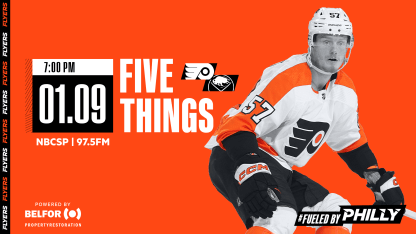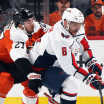Hitting the midpoint of their 2022-23 schedule, John Tortorella's Philadelphia Flyers (14-18-7) are in New York State on Monday to take on Don Granato's Buffalo Sabres (20-15-2). Game time at KeyBank Center is 7:00 p.m. ET.
5 THINGS: Flyers @ Sabres
Hitting the midpoint of their 2022-23 schedule, John Tortorella's Philadelphia Flyers (14-18-7) are in New York State on Monday to take on Don Granato's Buffalo Sabres (20-15-2)

GAME NOTES
The game will be televised on NBCSP. The radio broadcast is on 97.5 The Fanatic with an online simulcast on Flyers Radio 24/7.
This is the first of three meetings this season between the teams this season and the lone game in Buffalo. The Flyers and Sabres will rematch at the Wells Fargo Center on March 17 and April 1.
Here are five things to track in Monday's game:
1. Can the Flyers get right back on track?
The Flyers saw a four-game winning streak snapped on Sunday in a 6-2 home loss to the Toronto Maple Leafs. Philadelphia also failed to extend an eight-game streak of scoring at least three goals. Travis Konecny (21st goal of the season) and Nicolas Deslauriers (2nd) scored in a losing cause, narrowing a pair of two-goal deficits to a single goal in the first and second periods, respectively.
Puck management issues -- including a pair of Morgan Frost turnovers that ended up in Toronto goals -- and a very rough night as a team on both ends of special teams proved very costly in a game that was statistically pretty competitive from a possession and shot volume standpoint at 5-on-5. Toronto killed off four penalties, bagged a shorthanded goal, and went 1-for-2 on the power play.
Carter Hart was not sharp in net in this game, allowing two goals on shots where saves could be reasonably expected. On Toronto's shorthanded goal by Timothy Liljegren, the trouble started with a Hart turnover. He and the team got a temporary reprieve as a shot hit the crossbar and he covered for a stoppage. The ensuing faceoff was lost cleanly by Scott Laughton against Calle Järnkrok. Liljegren's point shot was a changeup that went between Owen TIppett's legs and then squeezed through Hart's pads,
Flyers defenseman Tony DeAngelo, who was charged with four giveaways and lost a battle deep in the defensive zone, was benched for the rest of the night after the first shift of the second period.
All in all, despite stretches where they held their own at five-on-five against a very good Toronto team, the Flyers deserved their fate in Sunday's game. They will need to play a cleaner game with the puck, be more opportunistic when they get chances and turn special teams into a positive -- or at least neutral -- factor in order to right the ship against Buffalo after what happened against the Maple Leafs.
2. Situational play: Dangers and Opportunities.
The Sabres are nobody's doormat anymore. If the 2022-23 season ended today, Buffalo would miss the playoffs for the 12th straight season (and 14th time in the last 16 campaigns). However, this is very much a team that now seems to finally be on the rise.
The biggest challenge the Flyers will face is to defend the middle of the ice, keep the Sabres from making plays out of the corners and not getting outnumbered. The current-day Sabres score a lot of goals. Buffalo enters this game ranked No. 1 offensively in the NHL with a robust 4.00 goals per game average.
The flip side: While they showed some team defensive improvements shortly prior to the leaguewide Christmas break, the Sabres have since reverted back to a lot of run-and-gun hockey and reliance on outscoring their breakdowns. Buffalo enters Monday's game against the Flyers ranked 24th in team GAA (3.43).
Prior to the Toronto game on Sunday, the Flyers had been in their best offensive groove of the season -- scoring at least three goals in eight straight games and scoring four or more goals in each of their previous five matches. That's a hopeful sign but it's still ill-advised for the Flyers to try to beat Buffalo at their own game in the Sabres' home arena.
In terms of situational performance and puck possession, this is how the two teams compare statistically:
5-on-5: PHI 72 GF, 81 GA (minus-9), BUF 88 GF, 79 GA (plus-9)
PP: Flyers 19-for-118 (16.1%, ranked 29th), BUF 40-for-138 (29.0, ranked 2nd)
SHGA: PHI 4, BUF 2
PK: PHI 30 GA-for-122 (75.4%, ranked 20th), BUF 34-for-123 (72.4%, 28th)
SHG: PHI 7, BUF 4
5-on-5 Corsi: PHI 46.99% (26th), BUF 51.84% (8th)
5-on-5 xGF%: PHI 45.28% (27th), BUF 49.06% (21st)
The bottom line is that the Flyers are up against a team that likes to put a lot of rubber at the net and generates, on average, north of 32 shots on goal per game. However, there's also opportunity here for Philly, The Sabres give up a lot in their own end of the ice and, even for all the goals they score, are slightly below the break-even point in quality of chances generated versus quality allowed. They also struggle at times to kill penalties, especially on home ice. The Sabres rank dead last in home PK percentage at 64.5 percent (opponents are 22-for-62).
Last but not least, the Sabres have scored on more than 30 percent of their power plays on home ice (22-for-71, 31 percent). The Flyers would do themselves a huge favor by avoiding offensive zone penalties, needless stick or restraining infractions and staying away from gifted power plays such as delay of game or too many on the ice.
3. Between the Pipes: Ersson the likely starter
Even if the Flyers and Hart had played a stronger game against Toronto on Sunday, chances are that the Flyers would have started Samuel Ersson in the second game of the back-to-back set. Philly will also be back in action on Wednesday at home against the Washington Capitals in the first game of a home-and-home.
Hart's season save percentage dropped below 91 percent (.909) after the Toronto game; the biproduct of stopping just 29 of 35 shots. While Hart was on Injured Reserve with a concussion, Ersson strung together three consecutive wins during the team's sweep of their California road trip.
Goaltending is still an area of need for the Sabres. The 41-year-old Craig Anderson has been a good stopgap (14 GP, 7-5-1, 2.61 GAA, .923 SV%, one shutout) while 23-year-old Finnish netmider Ukko-Pekka Luukkonen (13 GP, 9-3-1, 3.49 GAA, .894 SV%) has benefitted from strong goal support and found ways to win despite some inconsistency in his play. Twenty-seven-year-old Eric Comrie (11 GP, 4-7-0, 3.62 GAA, .887 SV%) is currently on IR.
4. Flyers Line Play
Apart from a seemingly likely switch of starting goalies for the second game of the B2B, the Flyers defense pairs could be tweaked for the game in Buffalo. Nick Seeler could exit the lineup in favor of Justin Braun. Of late, when Braun has been in the lineup, Cam York moves from right defense on the top pairing with Ivan Provorov to play left defense on the third pair. Correspondingly, ex-Sabres defenseman Rasmus Ristolainen moves up to play alongside Provorov.
Will DeAngelo get right back into the Flyers' lineup after watching from the bench for the final 39-plus minutes on Sunday? The thought here is that he will. His recent pairing with Travis Sanheim has generally had success of late. The Sabres' PK struggles and Philly's horrid PP performance on Sunday is another potential impetus to get DeAngelo right back out in his usual role. Last but not least, Nick Seeler in his own right was one of the many Flyers who had a rough night against the Maple Leafs.
Up front, Tortorella did some periodic line juggling against Toronto but primarily went with the same four combos that have been together regularly the last couple weeks. Unless Tortorella and Rocky Thompson are inclined to give Kieffer Bellows another shot at getting into the starting lineup rather than being scratched as the 13th forward, the now-familiar groupings may hold for the start of this game.
Potential lineup (speculatory and subject to change)
86 Joel Farabee - 49 Noah Cates - 11 Travis Konecny
25 James van Riemsdyk - 48 Morgan Frost - 74 Owen Tippett
13 Kevin Hayes - 21 Scott Laughton - 57 Wade Allison
44 Nicolas Deslauriers - 38 Patrick Brown - 17 Zack MacEwen
9 Ivan Provorov - 55 Rasmus Ristolainen
6 Travis Sanheim - 77 Tony DeAngelo
45 Cam York - 61 Justin Braun
33 Samuel Ersson
79 Carter Hart
5. Behind Enemy Lines: Buffalo Sabres
The Sabres have been hot of late, winning eight of their last 10 games including each of their last two outings. As noted above, the Sabres have become an offensive juggernaut. Defensive detail consistency and goaltending are the areas that still need to improve for Buffalo to become a playoff team. But the Sabres are now at least a bubble team for wildcard contention in the Eastern Conference after more than a decade of being a club accustomed to losing.
Buffalo is coming off a seesaw 6-5 home overtime win against the Minnesota Wild on Saturday. Buffalo led 1-0, trailed 2-1, scored three straight goals in the second period to forge a 4-2 lead, yielded three straight goals to fall behind by a 5-4 score, tied the game late in regulation to force overtime and then won the game with 19 seconds remaining in sudden death.
Viktor Olofsson opened and closed the scoring last game, including the OT winner, with his 14th and 15th goals of the season. Tage Thomson (PPG) notched his 31st goal of the season, and Dylan Cozens (PPG) tallied his 13th. Rasmus Dahlin scored his 11th and 12th goals of the campaign, including the goal at 17:36 of the third period that sent the tilt to OT, and also teed up Thompson's one-timer goal on the power play. Casey Mittelstadt collected three assists. In goal, Luukkonen was peppered with 44 shots, yielding goals on five but stopping 39.
The late-blooming Thompson, who has racked up 56 points (31g, 25a) in 37 games played was a thorn in the Flyers' side even before he started to light up the entire league over the course of last season. In the meantime, the top defensive pair duo of Dahlin (44 points, 26:26 TOI per game) and his shutdown-oriented partner Mattias Samuelsson (22:47 TOI per game) have become one of the best young blueline pairings in the NHL.
Based on the Sabres' morning skate, per Lance Lysowski of the Buffalo News, it appears that the team will roll with the same lines and defense pairs against the Flyers as they featured against Minnesota:
No changes to the Sabres’ lines/pairs:
— Lance Lysowski (@LLysowski) January 9, 2023
Skinner-Thompson-Tuch
Peterka-Cozens-Quinn
Mittelstadt-Jost-Olofsson
Girgensons-Krebs-Okposo
Dahlin-Samuelsson
Power-Clague
Bryson-Lyubushkin
Jokiharju-Fitzgerald


















